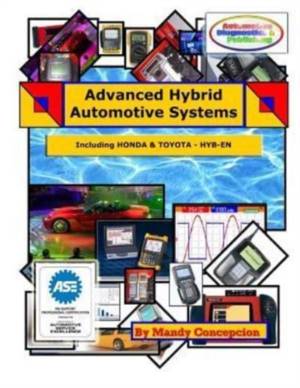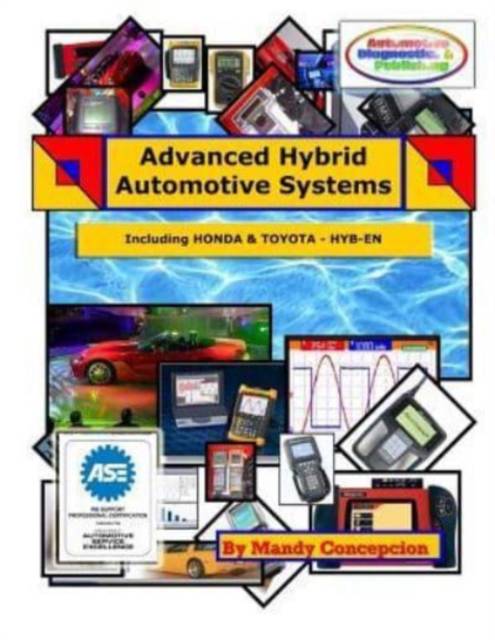
- Retrait gratuit dans votre magasin Club
- 7.000.000 titres dans notre catalogue
- Payer en toute sécurité
- Toujours un magasin près de chez vous
- Retrait gratuit dans votre magasin Club
- 7.000.0000 titres dans notre catalogue
- Payer en toute sécurité
- Toujours un magasin près de chez vous
Advanced Hybrid Automotive Systems
(Hybrid Systems Repair Strategies, including Honda and Toyota)
Mandy Concepcion
Livre broché | Anglais
30,95 €
+ 61 points
Description
The role of the modern automotive technician has changed drastically in the past decade. The job of today's vehicle specialist involves a deep knowledge of a wide variety of technical disciplines. Few professions encompass such a diverse understanding of technology. The automotive technician is now expected to know about chemistry, electronics, mechanics, optics, as well as posses a deep analytical mind. The last only comes with time and experience.Advanced HYBRID Vehicle Systems(vol 1), Including Toyota & Honda models By Mandy ConcepcionTable of ContentsCHAPTER 1 (Hybrid Basics and Safety Procedures)The Need for Hybrid SystemsHybrid Do's and Dont'sHere are some definite do'sHybrid basics and safety proceduresHybrid power down procedure and deactivationHigh voltage measurement and equipmentHumidity and high-voltageCHAPTER 2 (Hybrid Aerodynamics and Low Friction Tires)Low friction components and non-belt driven coolant pump, and air conditioning compressorThe AC systemEPS system, or electric power steeringReplacement of the actual electric motorPerforming a zero rest procedureCHAPTER 3 (Advanced Electronics for Hybrids)The dangers of amperage and High Current CircuitsCurrent measurements using an electromagnetic probe (clamp on)Voltage measurement on hybrid vehicles (advanced concepts)Measure the high voltage circuit at the orange cables after a power down procedureThe Dropping ResistorsCHAPTER 4 (Basic Electric Motor and Power Generation)Principle of InductionElectric Motors and Electric Alternating CurrentThe DC Electric MotorThe AC Electric MotorImportant facts about electric hybrid motor generator unitsTypical hybrid motor generatorDangers of Inverter Internal CapacitorsMotor Commutation PlatesHybrid Motor Position SensorMotor control techniquesDifference between a hybrid vehicle electrical motor and a regular AC motorThe TRIAC and IGBT (Isolated Gate Bipolar Transistor)Hybrid Regenerative BreakingCHAPTER 5 (AC and DC Power Units of Measurements)Frequency measurementsPhase MeasurementVoltage MeasurementsUsing a Clamp-On AMP ProbeThe 3 Phases of a HYBRID Motor (U, V, W)The Inverter Unit on the PriusDC Brushless MotorsCHAPTER 6 (basic battery technology)The nickel metal hydride batteryThe lithium ion batteryToyota Prius high Voltage batteryUltra-CapacitorsV R L A or variable regulation lead acid battery CHAPTER 7 (The 6 Hybrid Modes of Operation)HYBRID Computer System ControlLight Acceleration ModeRegenerative Breaking ModeDeceleration ModeNormal Driving ModeSTOP ModeM1's Biggest Contribution to the HYBRID UnitCHAPTER 8 (Parallel and Series Hybrid Systems)Series hybrid systemSeries, parallel, and series/parallel hybridInverter Power ManagementParallel hybrid systemParallel/Series hybrid systemToyota motor Co. and AISINCHAPTER 9 (The Prius CVT or continuously variable transmission)THS or hybrid synergy DriveTransmission Planetary GearsKey point to understanding the way this transmission worksHONDA CVT TransmissionHonda's Cylinder DeactivationHonda's Electric BalancingCHAPTER 10 (Toyota specific hybrid system)Specific concepts on the Toyota hybridProblems with the Coolant PumpGas Tank Rubber BladderCar Off AC SystemThe Scanner and the HYBRID SystemHigh Voltage BatteryMG1 and MG2 Power OutputThe Toyota auxiliary 12 V batteryHow to Jump Start a HYBRIDA Word About Toyota's Keyless EntryDangers of Electric Mode DrivingCHAPTER 11 (Honda specific hybrid system)The Honda hybrid system is vastly different than that of ToyotaHONDA Hybrid is a Simple DesignIMA or integrated motor assistThe Motor Generator UnitThe 12 volt StarterHonda Electronic BalancingThe 1.3L EngineSoft iridium spark plugsHonda Civic Complete Cylinder Deactivation
Spécifications
Parties prenantes
- Auteur(s) :
- Editeur:
Contenu
- Nombre de pages :
- 64
- Langue:
- Anglais
Caractéristiques
- EAN:
- 9781463552077
- Date de parution :
- 13-06-11
- Format:
- Livre broché
- Format numérique:
- Trade paperback (VS)
- Dimensions :
- 216 mm x 279 mm
- Poids :
- 172 g

Les avis
Nous publions uniquement les avis qui respectent les conditions requises. Consultez nos conditions pour les avis.






